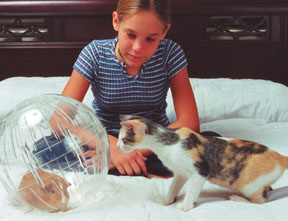
288
Youve seen the cute calendar photos: Rabbits and cats grooming each other, birds perched on cats heads like spring bonnets, and mice scrambling over a nursing feline. Everyone wants their cat to get along swimmingly with every family member, but these scenarios are atypical. Dr. Paul DeMars, DVM, of Oklahoma State University, warns owners to be cautious when combining species. Inside every cat is a predator, and a rabbit or bird is food for that cat, he says. You can never predict your pets behavior. However, if cohabitation is unavoidable, there are some guidelines that can create a safer and more harmonious home.
Timing Is Everything
During a kittens early life, they learn what a conspecific is: That is, they learn what another kitten is. Anything exposed to them at this critical stage of learning they accept as part of the family unit, explains Dr. DeMars, who is board certified by the American Board of Veterinarian Practitioners. If you are fortunate enough to acquire both pets during this period – Dr. DeMars suggests the first several weeks after birth – pull out your camera for Americas Funniest Home Videos. Dr. DeMars warns that this affection, unfortunately, wont necessarily extend to other animals of the same breed. Just because Fluffy likes Mopsey dont expect your recent Easter acquisition of Cotton Tail to be double the fun.
If your resident feline or new acquisition is older, there are some guidelines to follow and a few steps that can ease a pets transition into your home.
Small Can Spell Trouble: Size is your guide when determining if another pet will be at risk in the company of your cat. A parakeet or rodent is more likely to become dinner than a macaw or rabbit. Dont be fooled by large parrots. These birds have strong beaks that can inflict considerable damage to kitty.
Temperament Tips: Before combining your cat with prey, its useful to know the background of both animals – especially any experiences with the other species. You need to understand their body language and temperament so you can anticipate and prevent aggression. The more reactive an animal is, the more likely an attack will happen. The calmer the animal, the less likely it is to happen, says Dr. DeMars. Allow your new family member to adjust to your home and you before it meets your cat.
Besides your pets temperament, consider your own as well. Combining two species – especially the ones your cat covets – will require plenty of patience and diligence. Never let your guard down completely no matter how comfortable the animals appear.
Create Fort Knox: Every pet needs a space where it feels safe and free from a curious or predatory cat. Place its home in a location where your cat cannot tip it over and never allow your cat inside the other pets abode. Lids should be locked and bars spaced close together to prevent paw access. Create a hidden place inside the refuge that your pet can retreat to if it feels threatened or stressed.
Pet Pow Wow: Once you understand both pets dispositions, consider a face-to-face meeting. Introductions should occur in stages with no antagonistic behavior tolerated from either side.
Place both animals in the same room, with your new pet safely in its cage or a carrier. If you observe no overt aggressiveness, allow the animals to observe but not annoy one another. Never allow your cat to stare at potential prey to the point where it causes stress. Discourage this and other bad behavior with a stern word and a separation of the two.
At least once a day, securely lock your cat in another room to give your new pet an opportunity to safely explore your home. The exception applies to animals that can squeeze beneath doors, like mice or hamsters.
If after several weeks you have observed no hostility from either side, introduce your pets without a barrier between them. Hold the new pet securely and have another family member restrain your cat. If either animal struggles, consider abandoning your efforts in the short-term. If the first meeting goes well, however, consider allowing your pets to interact unrestrained. Your judgment and knowledge of your pets is your best guide.
Even if the animals appear friendly, Dr. DeMars is less sanguine. I would never trust a cat completely around another pet under any circumstance. The predator prey relationship is too instinctive.
Attack Advice
If your cat snatches your new addition, or vise versa, pay a visit to your veterinarian. Different species can introduce foreign organisms into one another and the results can be fatal. Afterwards, adjust your perception of your pets ability to live together. Next time, you may not be as lucky. As Dr.DeMars says, Some bites are inhibited bites intended as a warning, but with prey the bites are uninhibited and meant to do damage.



